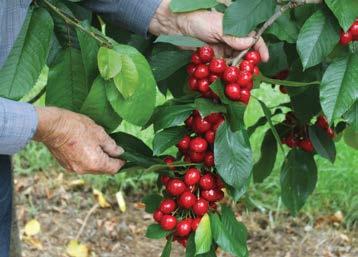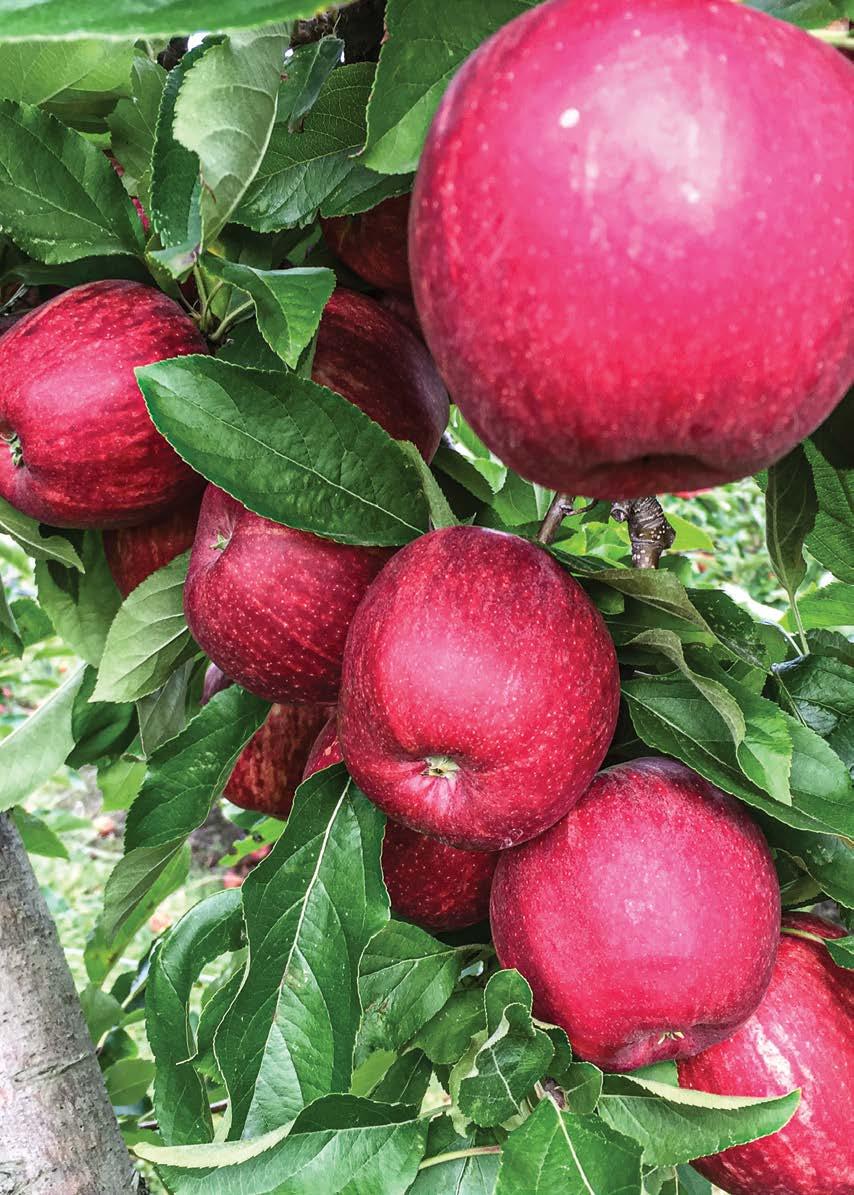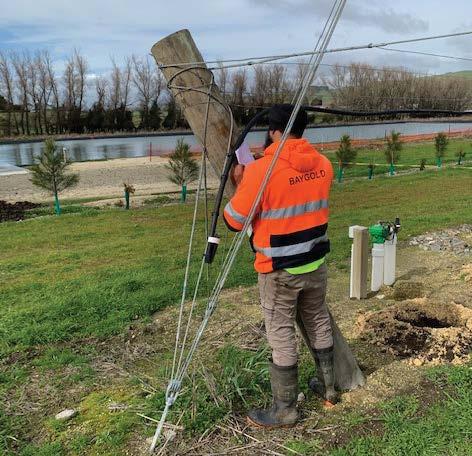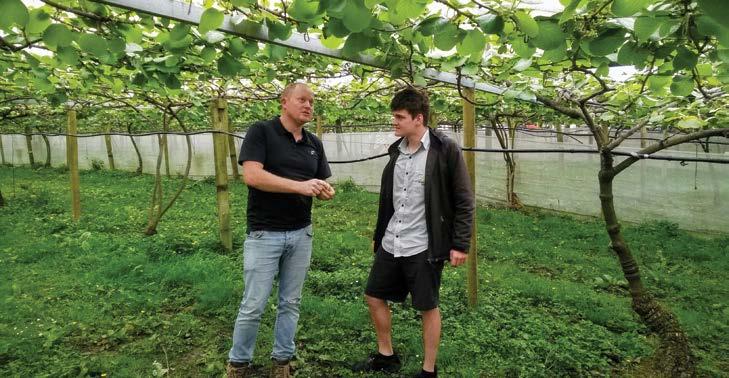
14 minute read
Championing best practice IP management and mentoring
Out of season cherries
By Mike Nichols
Cherries are probably the nicest of the stonefruit because you can eat just as many or as few cherries as you wish to consume at one time. A cherry is essentially a single mouthful whereas a single peach, plum or nectarine has to be consumed at one sitting.
New Zealand will never be a huge cherry production country simply because we do not have sufficient land or population to supply the enormous demand that exists for out of season cherries in the northern hemisphere. However, New Zealand has the potential to provide cherries to the northern hemisphere as a niche market, when prices are very high. This is because it is possible to produce cherries when other countries in the southern hemisphere have finished their harvest. South Africa, Chile, Argentina and Tasmania are all potential competitors, but most of their production occurs ahead of New Zealand and we are able to produce the crop later. Several years ago I discussed with Alan Bissett the possibility of using high tunnel houses for the production of cherries in the Wairarapa, thus overcoming the risk of split fruit during the harvesting season due to unseasonable rain and also to provide a support for netting to prevent our feathered friends having a very expensive breakfast. The purpose of this exercise was also to reduce the environmental risk particularly in relation to the possibility of climate change due to global warming. This risk of course also applies for those growers in Central Otago, Marlborough or Hawke’s Bay who grow outside without any protective cropping. At that time I did not consider the possibility of producing very early, or very late fruit, but more recently the premium that out of season fruit gets may make this a very attractive option. It is possible that in spite of global warming, there may be adequate winter chilling to permit cherries to be grown under high tunnels in Northland, and if not then by using dwarfing rootstocks (such as Gisella), cherry trees grown in containers can be overwintered in a coolstore, and transferred into the tunnel house at the appropriate time. The technology of growing in pots and transferring into a greenhouse for fruiting is not new. Paul Kinzett of Blenheim used it many years ago to provide the Japanese market with high quality cherries, however the possibility of using coolstores to ensure adequate winter chilling, with the use
New Zealand has the potential to provide cherries to the northern hemisphere as a niche market, when prices are very high
of dwarfing rootstocks and growing two dimensional trees is a relatively new concept. There is no way that Scotland could be described as ideal cherry growing country, but at least one producer, Matthew McIntyre in Blairgowrie, planted cherries in 2013. Using late maturing varieties such as Centennial and Sweetheart, he planted in polytunnels at a high altitude for Scotland. They are now producing acceptable crops and fitting into a niche market when there are no other cherries available in the northern hemisphere. New Zealand has the potential of undertaking a similar strategy to produce the latest cherries in the southern hemisphere, and therefore establishing a niche market of high-priced cherries at a similar cost to producing normal cherries. This is perhaps a strategy that New Zealand growers might consider in order to provide cherries over a longer period into the Asian market where there is a real demand for New Zealand produced cherries. Of course Chinese New Year is the key market window, but this is a moving feast (from 21 January to 22 February, depending on the moon), and this is further complicated by the effect of the weather on the maturing of the crop. There is little doubt that a market for late cherries (protected from any weather problems), would sell successfully in Asia. The real question is where to grow them. Perhaps this is the time for the Maniototo or Mackenzie Country to come into their own? Labour for harvesting and for grading and packing is likely to become less important in the future, as there is a huge increase in developing robotic harvesting methods using artificial intelligence to harvest many crops such as strawberries for instance, and it is only a question of time before this becomes available for cherries. Colour and weight grading equipment for cherries already exists, so it is really only a question of developing the necessary growing techniques for producing high quality cherries over an extended season.
The proven two-way attack on pests.

WIN* with Movento
Go into the draw to WIN* a R.M.Williams vest when you purchase Movento 100SC. See your local merchant for entry details.

*See website for T&C’s.
We’re with you in the field
cropscience.bayer.co.nz/movento-vest
Optimised two-way systemic activity, delivered by a class leading formulation.
Optimised formulation gives unparalleled penetration
Unrivaled and proven efficacy
Proven crop safety
Soft on key beneficials
Movento 100SC - for results you can trust.
What makes a good workplace assessor?
The workplace assessor is an important part of the training cycle.
By Eve Williams : Sector Lead – Marketing, Primary ITO
They oversee the formal marking process and provide mentoring, either within their own workplace or independently. They are a vital part of maintaining the quality of Primary ITO (Industry Training Organisation) qualifications and programmes.
A workplace assessor is a person such as an experienced supervisor or manager, who works in an organisation that has trainees. They are registered with Primary ITO as a workplace assessor to assess employees in their workplace. The workplace assessment task is performed in addition to their normal duties.
Because the assessor plays such an important role in the learner experience, there are some processes in place to ensure that learners, employers and assessors are getting a consistent quality of experience. In addition to being registered as workplace assessors with the Primary ITO, our workplace assessors are expected to have a minimum level of professional assessor training (Unit Standard 4098 for workplace

Kamarpal Singh explains how to put up a kiwifruit structure as part of a workplace assessment and affiliate assessors, and Unit Standard 30421 for ITO training advisers). The Primary ITO Quality team also regularly reviews the workplace assessors’ professional practice, and assessors are expected to participate in ongoing professional development workshops offered by the ITO. Workplace assessors have a lot of responsibility – they’re required to make the final decision regarding a learner’s competency, and they have the authority to register the assessment results with Primary ITO, who report those to the NZQA (New Zealand Qualification Authority). After registering results, all workplace assessors have to hold the evidence of their judgement for a minimum period of two years.
Assessment and learning are linked
When assessment happens during learning, it is usually informal and known as formative assessment. Formative assessment happens when a supervisor gives a trainee feedback on how they are getting on with a particular aspect of their work. Summative assessment, on the other hand, is what happens when the supervisor considers that the apprentice is ready to demonstrate knowledge of the different elements of particular tasks – this happens at the end of a particular learning process, and is when a judgement is made that the standards have been met. Summative assessment results tell us whether or not the person has met the standard. Formative assessment helps the learner to reach that standard.
Assessment is an on-going process not a one-off event
When well designed and implemented, assessment provides opportunities for trainees to demonstrate the knowledge and skills required to meet competency standards set out by the ITO. It is therefore not just a ‘oneoff’ event that happens between assessors and trainees. Assessment is the evidence-gathering process carried out by trainees, verifiers, and assessors that supports trainees to achieve what is required for gaining qualifications.
SO GIVEN HOW IMPORTANT THE ROLE OF A WORKPLACE ASSESSOR IS, WHAT MAKES A GOOD WORKPLACE ASSESSOR?
A successful assessor takes pride in their work and is honest and assesses to the principles.
As an assessor, definiteness of decision is important. Assessors must be strong in their decision making, as the alternative of being uncertain undermines authority and erodes your student’s confidence and trust in you.
An assessor needs to plan the process and timing to ensure they have the ability to gather the evidence that may be needed.
Understanding the learner’s perspective, but
Diagram demonstrating the triangulation of assessment

Validity and reliability are strengthened when there are several sources of evidence
Workplace learning frequently involves dividing the roles of teacher or trainer, assessor, and evidence collector between different people. This makes workplace learning different from other institutional educational settings. It can be an assessment strength to have different people in different roles because they can contribute to broader that the evidence can be triangulated.
and potentially more valid judgments of achievement than relying on the judgment of one individual.
Assessors need to be committed to learning and have other important attributes
We require assessors who are committed to the industry and to supporting learners and employers. Workplacebased assessors are often nominated by others for the role and on the basis of their technical expertise. It is important to also consider other attributes such as good communication skills, literacy and numeracy skills, thoroughness, and trustworthiness, because these are essential to being a good assessor. The ability to assess across a range of unit standards requires assessors to have a deep understanding of what they are assessing, There are massive benefits for a workplace having its own assessors. It means that: • The trainee can be assessed without having to stop working or travel somewhere. • The assessor intimately understands the workplace and often know the trainee. • The assessment costs are often reduced for the organisation. • It’s easier to adjust assessment practices to suit the workplace situation and the trainee.
Integrity
Definiteness of decision
The ability to manage one’s time effectively
A professional demeanour
maintain the integrity of the assessment methodology, and maintaining trainee confidentiality.
Empathy
A great assessor can step outside themselves and take the time to understand their learners’ situations.
Attention to detail
Ensuring the completeness of assessment and as well as the important ‘soft skills’.
Willingness to assume full responsibility
An assessor must set a good example for their students. Sometimes this involves admitting when they are wrong and being responsible for their decisions and the results.
The ability to be cooperative
Cooperation is essential when it comes to the successful relationship between a student and their assessor.
So you want to be a workplace assessor? The general rule of thumb is that workplace assessors are people with Primary ITO trainees working in their businesses, and who have at least eight years’ industry experience, or hold a New Zealand recognised relevant Horticulture qualification. If you have a potential trainee looking to upskill, and you feel you have the attributes to be a good workplace assessor, get in contact with Primary ITO.
https://www.primaryito.ac.nz/contact-us/

Punchbowl Simon Craig (left) and Keegan Neate
Attracting horticultural talent… and holding it
A Pukekohe kiwifruit operation has found it hard to attract young people into the business despite its proximity to Auckland city. So Punchbowl has started finding young local high school students who have an interest in horticulture as a career, offering scholarships to two Pukekohe High School students to take them through their studies.
By Glenys Christian
General manager, Simon Craig, says horticulture suffers from a bad image with young people wrongly thinking its only about hard, boring manual labour.
“There’s a misconception of what the industry’s all about,” he says. “There’s a huge variation of careers in the industry from agronomists through to accountants.” Being close to a major city means Pukekohe’s horticultural businesses have to compete against other options which might be more immediately appealing to young people such as IT and retail. “It’s been hard to find people that are suitable that have experience for managerial positions,” he says. “So now we grab them early and hold on to them.” About five years ago Pukekohe local, Chris Lowe, contacted him through a friend of a friend and after working at Punchbowl gained a scholarship from the company to complete his studies at Massey University. And next year it will be the turn of Keegan Neate. He took part in a Pukekohe High School Horticulture Pathways programme last year organised by its head of agriculture and horticulture, Dave Matthews, under which a number of pupils spent three days each on work experience at three local businesses, Punchbowl, A S Wilcox and T & G Global then a follow up day at each. “We were showing them different facets of the business so they got a proper introduction to horticulture,” Simon said. That took a bit of work for the companies involved with monthly meetings to organise the schedule, but the rewards were clear to him when he saw that three or four of the students really engaged with the industry’s While he hasn’t said too much to school friends about his scholarship, his parents’ approval was immediate. “They’re stoked,” he said.
opportunities. The plan is to add in another three or four horticultural businesses to the programme and repeat the exercise next year.
Keegan appreciated the structure which Punchbowl used to show the breadth of what a career in horticulture could offer. “It was very informative and the people were friendly,” he says. “We were shown how much there is to looking after plants.” He so impressed Simon that he was offered work over the summer, then returned to do afternoon shifts through the packing season. “He’s been hugely valuable and did everything we offered to him,” he says. So, he’ll be heading off to Massey University next year to start on the three-year Bachelor of Horticulture Science with the help of a Punchbowl scholarship. Simon jokes that Keegan’s choice of university is much to his disgust as he, his father Rob, brother Shane and sister Nikki, who all work at Punchbowl, went to Lincoln. But he understands that the small number of horticulture majors there now make Massey a more attractive option. After he graduated, he managed the kiwifruit orchards for OPAC (Opotiki Packing and Coolstorage) for eight years before returning home to the family business which now owns, leases or manages 186ha of kiwifruit from Whangarei to Pukekawa. It employs 80 full-time staff and around 300 seasonal workers over harvest. It also grows blueberries at its Glenbrook Road base outside Pukekohe, with expansion plans including on-site backpacker accommodation. A packaging business is also run from here that supplies the horticultural industry, and has won two World Star Packaging Awards for its compostable blueberry punnets. should be attracted into horticultural careers when they’re around 14.
“That’s the right timing because there’s more freedom in your subject options,” Keegan said. He’s grown his own vegetable plants from a young age, and has now taken over his parents’ garden as well as getting stuck in on his grandparents’ lifestyle block. Both Simon and Keegan agree that students ideally
“They’re pretty level-headed people.” He took part in a recent horticultural careers expo where Punchbowl was one of nine different growers or servicing industries which had stands. Simon says it was a good way of opening students’ minds to the huge horticulture industry presence close to Auckland, which many were unaware of.
“It’s a good diverse industry,” he says. “You’re not stuck in front of a computer all day and if you like to be outside it’s ideal.” He believes schools are key when it comes to correcting some of the “bad rap” that horticulture gets when it comes to common perceptions about the use of chemical sprays and pay rates. Punchbowl, like other horticultural businesses around Pukekohe, didn’t slow down at all over the Covid-19 lockdowns, which he hopes will bring about a shift in awareness as to their importance. “It’s really shown what the key industries are in the world, as people have to eat.”
ORCHARD MACHINERY FOR SALE
Airblast Sprayer Pearce 2000ltr.
Excellent condition $3,000 (+GST)
Fruit Grading Machine 14 Mtrs long.
Very good condition $7,000 (+GST)









